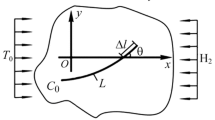Abstract
The process of hydrogen absorption in a cylindrical cladding with residual stresses has been considered. The latter ones occur in the material of products when carrying out different technological operations. The level and character of the residual stresses distribution change kinetics of diffusion migration of hydrogen atoms. The process of hydrogen absorption is described by a non-stationary diffusion equation in the field of forces under corresponding initial and boundary conditions. The analytical relations for the field of hydrogen atoms concentration have been given. Possibility of decreasing the near-surface barrier for diffusion migration of the hydrogen atoms into the volume of the metal are discussed. The analytical analysis results are attracted for explaining physical mechanism of the hydrogen atoms absorption with the residual stresses.
Access this chapter
Tax calculation will be finalised at checkout
Purchases are for personal use only
Preview
Unable to display preview. Download preview PDF.
Similar content being viewed by others
Abbreviations
- C:
-
Hydrogen concentration
- C1:
-
Hydrogen concentration with absorption from the inner surface
- C2:
-
Hydrogen concentration with absorption from the outer surface
- D:
-
Hydrogen diffusion coefficient
- k:
-
Boltzmann’s constant
- T:
-
Absolute temperature
- C0:
-
Average concentration of hydrogen atoms
- r0:
-
Inner cladding radius
- R:
-
Outer cladding radius
- μ:
-
Shear modulus
- νl:
-
Poison’s ratio
- ω:
-
Angle of rotation of the cladding cut edges
- σ ll :
-
First invariant of the residual stresses tensor
- ςν:
-
Change of metal volume when placing hydrogen atoms
- C1p and C2p:
-
Equilibrium concentrations of hydrogen atoms on the inner and outer cladding surfaces
References
Vlasov N.M., Fedik I.I. Decomposition of Solid Solution in Residual Stresses Field. Dokl.Acad. Nauk (Physics) 2002; 382 (2): 186–189.
Teodosiu C. Elastic models of crystal defects. Moscow: Mir, 1985.
Kolachev B.A. Hydrogen brittleness of metals. Moscow: Metallurgy, 1985.
Lurie A.I. Theory of Elasticity. Moscow: Nauka, 1970.
Vlasov N.M. Fedik I.I. Diffusion of Interstitial Impurities through Cylindrical Cladding with Residual Stresses. Dokl. Acad. Nauk (Physics) 2002; 384 (3):324–327.
Libowitz G.G., Maeland A.J. Hydride formation by BCC solid solution alloys. Materials Science Forum. 1988; 31: 176–196.
Pick M.A., Greene M.G., Strongin Myron. Uptake rates for hydrogen by Nb and Ta: effect of thin metallic overlayers. J. of the Less-Common Metals. 1980; 73, 89–95.
Author information
Authors and Affiliations
Editor information
Editors and Affiliations
Rights and permissions
Copyright information
© 2004 Kluwer Academic Publishers
About this paper
Cite this paper
Vlasov, N.M., Fedik, I.I. (2004). Hydrogen Segregation in the Residual Stresses Field. In: Veziroglu, T.N., Yu. Zaginaichenko, S., Schur, D.V., Baranowski, B., Shpak, A.P., Skorokhod, V.V. (eds) Hydrogen Materials Science and Chemistry of Carbon Nanomaterials. NATO Science Series II: Mathematics, Physics and Chemistry, vol 172. Springer, Dordrecht. https://doi.org/10.1007/1-4020-2669-2_40
Download citation
DOI: https://doi.org/10.1007/1-4020-2669-2_40
Publisher Name: Springer, Dordrecht
Print ISBN: 978-1-4020-2668-3
Online ISBN: 978-1-4020-2669-0
eBook Packages: Chemistry and Materials ScienceChemistry and Material Science (R0)




